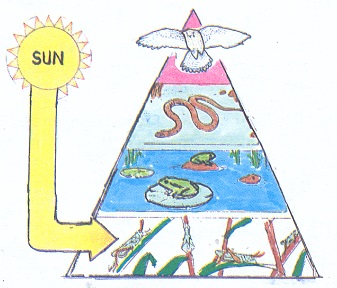What is an energy pyramid, food chain? How Is Energy Passed Through a Food Chain? The Effect of Harmful Substances On The Food Chain
Every organism needs energy. Green plants make their food by photosynthesis. Some animals eat plants and others eat the animals that feed on plants. As food passes through a food chain, energy is obtained for use by each of the organisms in the chain.

The grass-mouse-snake food chain is a good example of the transfer of energy from one organism to another. The grass uses sunlight to make and store food. When a mouse eats grass, the energy and nutrients stored in the grass are passed on to the mouse. The mouse uses some of the energy and nutrients for its life activities. The rest of the energy and nutrients are stored in the mouse’s body. When a snake eats the mouse the energy and nutrients in the mouse are passed on to the snake. In turn; the snake uses the energy and nutrients it needs and stores the rest. The transfer of energy is not 100% efficient. Organisms use about 90% of the energy in the food they eat. The remaining 10% is stored in their bodies (About 9/10 of the energy of food consumed at each level of a food chain is used up in life activities. Only 1/10 of the energy of food is converted to living substances, this is all that is available for the next level in the pyramid).
An energy pyramid is a diagram that shows the flow of energy through a food chain. The energy pyramid is divided into levels. The first level represents producers while consumers make up the upper levels.
The first level is the largest because it is the level with the most energy. Plants get their energy directly from the sun. The next level of the pyramid is smaller that the first because the plants have used most of the energy (90%) for their own needs. A small amount (10%) of the energy in the plants is passed to the grasshopper. When the frogs eat the grasshoppers the energy and nutrients stored in the grasshoppers are passed on to the frogs, and so on. The shape of the pyramid shows that the least amount of energy is available to the hawk.
Is more energy available to the carnivores or to the herbivores? Why?
More energy is available to the herbivores because their feeding order is closer to the beginning of food chain.
What happens to the organisms at the end of a food chain that cannot get enough food to supply their energy needs?
The organisms do not survive. They may even become extinct unless man changes their environment.
The Effect of Harmful Substances On The Food Chain
All the materials people use and all the foods people eat come from the environment. The number of human beings is increasing rapidly. They need more food and other products to survive. For example, people have cut forests for lumber and other products. Forests have also been cleared to make more land for farming. When forest is cut down, most of the animals die, because their homes have been destroyed and their food chains have changed.
Chemicals that are used to kill insects do not only kill the organisms that they are intended to kill. Some of these chemicals enter the food chain and are passed on. These chemicals first enter the soil, then they become a part of the plants that grow in the soil. Herbivores eat the plants and, in doing so, they receive some of the chemicals. So the chemicals are passed along a food chain such as the grass-grasshopper-bird food chain. A Grasshopper eats a lot of grass and a bird eats many grasshoppers, and so on. As a result the amount of chemicals increases in the bodies of the animals in the food chain.
Some years ago the very poisonous chemical DDT was used to kill insects. Birds that ate these poisoned insects also became affected by the DDT and this caused them to lay eggs with very thin shells. The shells were so weak that mother birds crushed the eggs when they sat on them.
DDT is very harmful to the environment in many other ways. In the process of killing insects, plants were also sprayed and the DDT remained on the leaves until autumn, when they fell to the ground. Earthworms then fed on the leaves, so the DDT passed into the earthworms. Birds then ate the earthworms, so the DDT passed into the birds. Once in the birds it often damaged their sound chords and eventually killed them.
DDT does not only poison insects and birds. It also affects humans, where it becomes stored in body fat and can lead to cancer and damage to the liver, adrenal glands and nerves.
Organic (waste of animals) and inorganic (man-made) fertilizers are added to soil to increase its fertility. Putting too much fertilizer on the soil can cause pollution. If a lot of fertilizer is added to soil, it may drain into lakes and rivers. Fish and other aquatic animals in lakes and rivers become seriously ill and some die. People may also become ill when they eat poisoned fish.